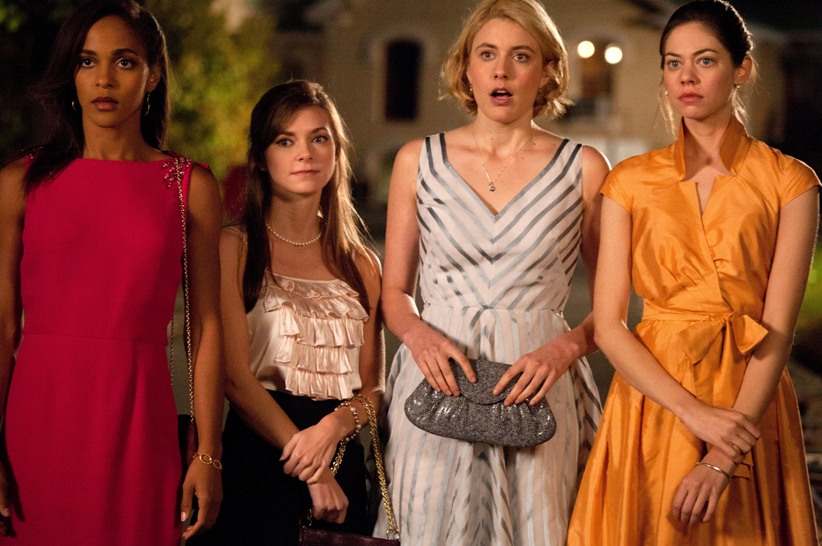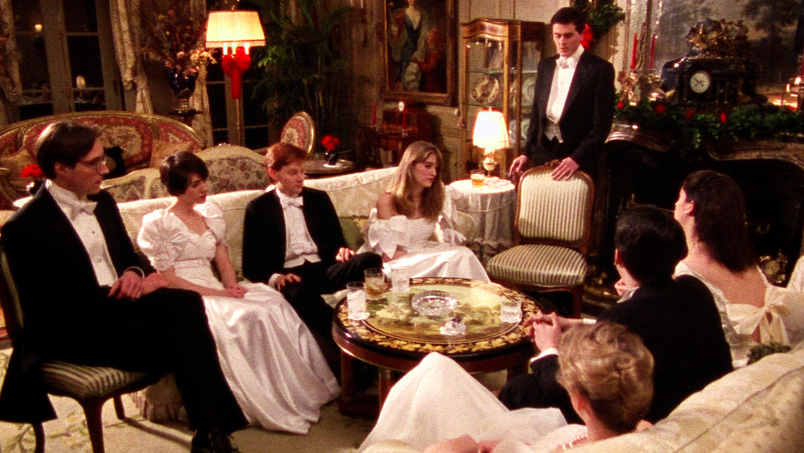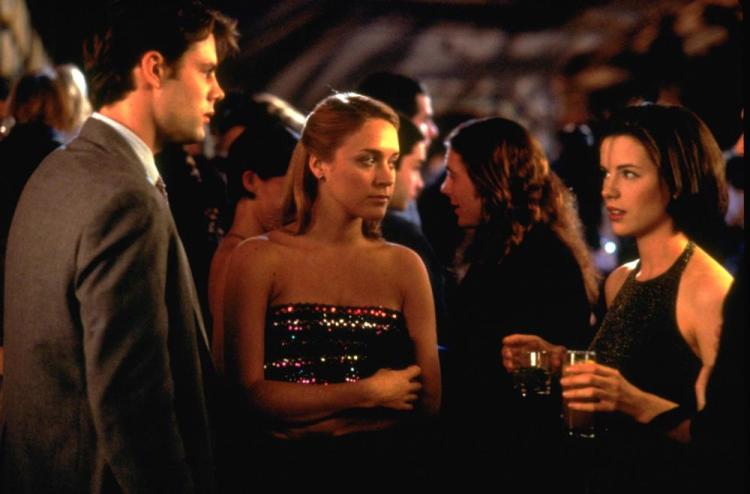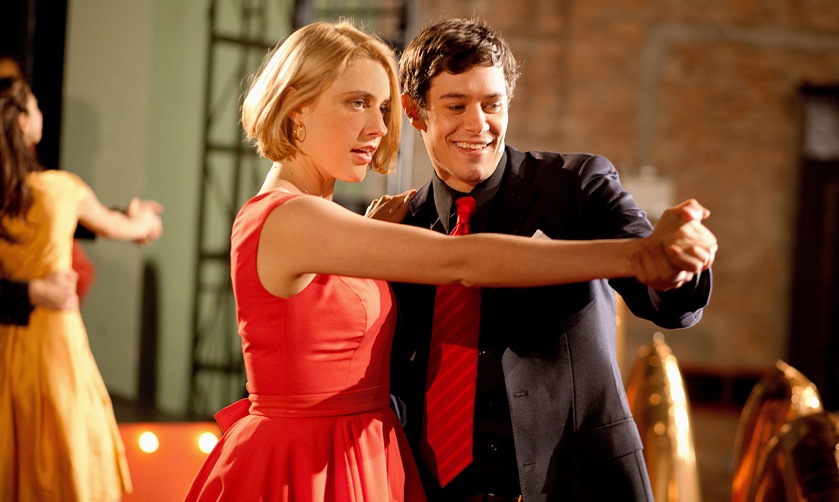Interview: Whit Stillman, Metropolitan Filmmaker | reviews, news & interviews
Interview: Whit Stillman, Metropolitan Filmmaker
Interview: Whit Stillman, Metropolitan Filmmaker
The director explains why his new film Damsels in Distress has been so long in the pipeline

Unlike the New Seekers, Whit Stillman does not want to teach the world to sing. He does, however, want to teach it to dance, specifically to dance the Sambola (or, to give it its full name, Sambola! The New International Dance Craze). Instructions and a demonstration accompany the final credits of his new film, Damsels in Distress.
Social dancing plays a large role in all of Stillman’s work. His breakthrough, Metropolitan (1990) - which earned him an Oscar nomination for Best Screenplay and became a Withnail and I-level cult success with fans still quoting favourite lines years later - is set during New York’s debutante season, and is largely made up of either pre- or post-dance conversations. A Studio 54-like venue is the focal point of his third film, The Last Days of Disco (1998), and a project he’s been developing since 2007 about the Sixties church music scene in Kingston, Jamaica is called Dancing Mood.
People wouldn’t do a project because they said it was too small for them
“I was at a boys’ boarding school and our only chance to meet girls was at dances,” he explains. “So for me dancing is invested with romance.” For Violet, the heroine of Damsels, it’s also invested with the power to rescue the clinically depressed. Tap dancing is one of the therapies on offer at the campus Suicide Prevention Center she’s established, along with coffee and donuts. She’s also a great believer in the healing power of hygiene and restorative scents (this last inspired by the fragrance of an Asprey’s soap Stillman encountered in a Dublin hotel). Fortunately, Violet is played by indie film girl of the moment Greta Gerwig (pictured below, second from right), whose level gaze, swimmer’s shoulders, and grave purposefulness help ground what could have been her character’s stratospheric twee factor.
 Violet is the leader of a small clique of attractive, well-groomed college girls, but they are not an exclusionary bitchy gang like the Plastics of Mean Girls. They are instead painfully sincere Nice Girls (all named after flowers, making them not so much a gang as a bouquet), devoted to improving the lives of their fellow students, whether or not their help is welcome.
Violet is the leader of a small clique of attractive, well-groomed college girls, but they are not an exclusionary bitchy gang like the Plastics of Mean Girls. They are instead painfully sincere Nice Girls (all named after flowers, making them not so much a gang as a bouquet), devoted to improving the lives of their fellow students, whether or not their help is welcome.
The adoption of transfer student Lily gives Violet the opportunity to expand on her principles in a series of ambulatory Socratic dialogues (like that other dialogue-driven writer, Aaron Sorkin, Stillman is fond of the walk-and-talk) peppered with rhetorical questions such as “does the world need more eccentrics?”
Populating his films with middle-class people who speak in complete sentences about abstract ideas has prompted comparisons with Eric Rohmer and Woody Allen. “It’s good for triangulating,” says Stillman, “but I don’t feel the films are actually close to the films of either of those guys” - although he does feel Damsels is closer to Allen’s more “silly and funny” recent work.
While it’s true that, like Allen, Stillman is best known for depicting the world of the “urban haute bourgeoisie” (a categorisation introduced by one of Metropolitan’s teenage characters (pictured below), in what was perhaps a nod to Stillman’s godfather, eminent sociologist Digby Baltzell, who first coined the term WASP), there are crucial differences. Allen got himself from ethnic Brooklyn to tony Fifth Avenue by his own efforts, and his characters rarely question their privileges or worry about their place in the wider world. Stillman’s New York, on the other hand, is one of inherited wealth and his preppie characters are not only ambivalent about whether they deserve their status but are fully aware that their ascendancy may be in decline. Some of them, unlike Allen’s characters, even have genuine money worries (like his Metropolitan protagonist, Stillman had the antecedents but not the cash to move in deb circles).
 And while WoodyWorld is more or less uniformly white, Damsels, Stillman explains, had a “mandate to have as many minority characters as possible.” The most acerbic, hence memorable, of Violet’s acolytes is Rose (Megalyn Echikunwoke), a posh Black British (or is she?) student convinced every friendly male is an “obvious playboy-operator type”, and when a broken heart drives Violet to seek solace in a downtown diner, she encounters a melting pot of actual working-class people (albeit ones who speak just as epigrammatically as her college chums and who appear equally susceptible to the consoling powers of fragranced soap.)
And while WoodyWorld is more or less uniformly white, Damsels, Stillman explains, had a “mandate to have as many minority characters as possible.” The most acerbic, hence memorable, of Violet’s acolytes is Rose (Megalyn Echikunwoke), a posh Black British (or is she?) student convinced every friendly male is an “obvious playboy-operator type”, and when a broken heart drives Violet to seek solace in a downtown diner, she encounters a melting pot of actual working-class people (albeit ones who speak just as epigrammatically as her college chums and who appear equally susceptible to the consoling powers of fragranced soap.)
Watch the trailer to Damsels in Distress
Stillman does however feel an affinity with Wes Anderson, director of The Royal Tenenbaums and The Life Aquatic With Steve Zissou, who is similarly drawn to well-off, eccentric, articulate characters and deadpan wit. Anderson has become a leading light of what might be called the New Whimsy, creating stylised films that some find refreshingly original and others unbearably mannered and arch.
It is an aesthetic embraced by several of America’s more trendy younger artists (step forward Zooey Deschanel and Miranda July), and in fact the turning point for Damsels came when Lena Dunham, director of ultra-hip breakout projects Tiny Furniture and HBO’s Girls - about affluent, self-aware, verbal New York youth that balance between endearing and infuriating - introduced Stillman to her producer.
It has been a long slog. After Disco, Stillman tried to get scripts into production for over a decade without success, despite his track record. “The comment I found so infuriating,” he says, “was when people wouldn’t do a project because they said it was too small for them. Even if they think the movie’s going to come out and get good reviews and get a good response, the amount of money that can be made on a small release won’t pay for their inflated salaries, therefore they won’t do it.”
 Even Stillman’s ability to keep costs down didn’t help. “I remember talking to a producer about how inexpensively I could make a movie and logically that should be good,” he recalls. “If you can make a movie for 1.5 million that will return 3 million, that’s fantastic. But that’s not the psychology people have. They say, ‘The film has to cost five million so I can charge my $250,000 producer fee.’ My best friend, who was also an investor in Metropolitan, said, ‘People talk in the film business the way the gang about to knock over a bank talk, except in the film business they divide up the loot before they do the job.’”
Even Stillman’s ability to keep costs down didn’t help. “I remember talking to a producer about how inexpensively I could make a movie and logically that should be good,” he recalls. “If you can make a movie for 1.5 million that will return 3 million, that’s fantastic. But that’s not the psychology people have. They say, ‘The film has to cost five million so I can charge my $250,000 producer fee.’ My best friend, who was also an investor in Metropolitan, said, ‘People talk in the film business the way the gang about to knock over a bank talk, except in the film business they divide up the loot before they do the job.’”
To make ends meet, Stillman, by now living in Paris with his then-wife and two daughters, worked as a jobbing writer, turning Last Days of Disco (pictured above left) into a novel and writing TV pilots for hire. He even applied for a job directing Gossip Girl, but, despite having directed one of the most sophisticated, accurate representations of the GG milieu ever, was turned down.
It probably would not have been a happy marriage. GG’s Upper East Siders are more like refugees from Dynasty, or perhaps TOWIE, concerned primarily with power, sex, and shiny objects, whereas Metropolitan’s (pictured above) have at least a passing acquaintance with culture, literacy, and introspection. “The version of those people in Gossip Girl is really the opposite our version of those people. It’s very far away from anything. It’s totally fake.”
Damsels has been described as Austen meets Animal House. Stillman accepts the comparison with the latter
Given these setbacks, it would not be surprising if Stillman’s tone had become darker, more astringent, more, well, waspish. However, he seems remarkably unscathed. Not only does he still, at 60, have a rather youthful air, with preppyish floppy hair and slim build (all that dancing has paid off) despite being somewhat drawn at the end of a long PR push, but his outlook seems sunnier and less elegiac than it was when he made Metropolitan at 38. “All the first three films had a Utopian quality,” he says, “but this film is more than that because all the protagonists are nutty Utopians trying to create a retro-utopia in a modern world.”
Violet’s Seven Oaks College (not an Ivy League university as some commentators have suggested, but definitely, according to Stillman, “a small liberal arts college, probably in Pennsylvania”) is a kind of Forest of Arden, where disguises are assumed and revealed and couples bond in revolving combinations, with no grudges held for long. Like all inhabitants of Utopia, Violet and her associates seem to exist out of time, with classic clothes, hair styles, and slang-free dialogue (no “totes, whatevs” here), despite allusions to exotic sex (one couple breaks up over the young man’s adherence to an obscure religious cult that permits intercourse only if it’s anal) and modern drugs (mood-altering prescription as opposed to recreational).
Most retro of all is the absence of mobiles, computers, and even televisions. There’s a brief glimpse of an iPhone and one of a computer, but that’s about it. “We had more laptops but cut them out. There was a conscious effort to keep it timeless.”
Largely thanks to a toga party scene, Damsels has been described as Jane Austen meets Animal House. Stillman happily accepts the comparison with the latter, describing it as “another Harvard Utopian view of what a ‘real’ college with frats is like.” (A co-writer of Animal House went, like Stillman, to Harvard). But where the party in Animal House was a rowdy bacchanal in none-too-clean bedsheets, Damsel’s is an afternoon pastoral in freshly laundered, perfectly tied togas. And Animal House takes a dyspeptic view of frats, seeing them as a breeding ground for conformity and authoritarianism, whereas Violet views them as a refuge for creatures, more to be pitied than scorned, too stupid to survive in the wild (her own frat boyfriend makes Tim-Nice-But-Dim look like Charlie Brooker).
 Like another of his favourite directors, Bill Forsyth, Stillman leans towards a positive view of human nature, and it is this absence of cynicism combined with polished manners (not to mention old-fashioned unmediated conversation) that truly gives Damsels its retro feel. Its tuletary deity is Fred Astaire. In fact the film concludes with the cast singing and dancing past fountains in a rendition of “Things Are Looking Up”, an Astaire number from the 1937 film A Damsel In Distress (co-written by P.G. Wodehouse, another spirit looming large over this film) and Stillman readily admits that he hopes his Damsels will cheer audiences up in these austere times much as the Astaire-Rogers concoctions did during the Great Depression. “Absolutely. That’s the intention,” he says.
Like another of his favourite directors, Bill Forsyth, Stillman leans towards a positive view of human nature, and it is this absence of cynicism combined with polished manners (not to mention old-fashioned unmediated conversation) that truly gives Damsels its retro feel. Its tuletary deity is Fred Astaire. In fact the film concludes with the cast singing and dancing past fountains in a rendition of “Things Are Looking Up”, an Astaire number from the 1937 film A Damsel In Distress (co-written by P.G. Wodehouse, another spirit looming large over this film) and Stillman readily admits that he hopes his Damsels will cheer audiences up in these austere times much as the Astaire-Rogers concoctions did during the Great Depression. “Absolutely. That’s the intention,” he says.
Recreating the effortless charm of the Fred-and-Ginger movies is a tricky proposition. The Artist, another spirit-lifting film that concludes with a big tap-dance number, pulled it off by always reminding us of the real emotion underlying all the style and artifice. Get the balance wrong, however, and you end up on the toe-curling side of the New Whimsy, with the movie turning into a soufflé that fails to rise. Damsels in Distress will probably be a Marmite film, but it's to be hoped that enough people will like it to ensure there won’t be another long hiatus before Stillman’s next production. But don't count on The Sambola! catching on.
- Damsels in Distress opens on Friday
Explore topics
Share this article
Add comment
The future of Arts Journalism
You can stop theartsdesk.com closing!
We urgently need financing to survive. Our fundraising drive has thus far raised £49,000 but we need to reach £100,000 or we will be forced to close. Please contribute here: https://gofund.me/c3f6033d
And if you can forward this information to anyone who might assist, we’d be grateful.

Subscribe to theartsdesk.com
Thank you for continuing to read our work on theartsdesk.com. For unlimited access to every article in its entirety, including our archive of more than 15,000 pieces, we're asking for £5 per month or £40 per year. We feel it's a very good deal, and hope you do too.
To take a subscription now simply click here.
And if you're looking for that extra gift for a friend or family member, why not treat them to a theartsdesk.com gift subscription?
more Film
 Don't Let's Go to the Dogs Tonight review - vivid adaptation of a memoir about a Rhodesian childhood
Embeth Davidtz delivers an impressive directing debut and an exceptional child star
Don't Let's Go to the Dogs Tonight review - vivid adaptation of a memoir about a Rhodesian childhood
Embeth Davidtz delivers an impressive directing debut and an exceptional child star
 One Battle After Another review - Paul Thomas Anderson satirises America's culture wars
Leonardo DiCaprio, Teyana Taylor, and Sean Penn star in a rollercoasting political thriller
One Battle After Another review - Paul Thomas Anderson satirises America's culture wars
Leonardo DiCaprio, Teyana Taylor, and Sean Penn star in a rollercoasting political thriller
 Steve review - educator in crisis
Cillian Murphy excels as a troubled headmaster working with delinquent boys
Steve review - educator in crisis
Cillian Murphy excels as a troubled headmaster working with delinquent boys
 Can I get a Witness? review - time to die before you get old
Ann Marie Fleming directs Sandra Oh in dystopian fantasy that fails to ignite
Can I get a Witness? review - time to die before you get old
Ann Marie Fleming directs Sandra Oh in dystopian fantasy that fails to ignite
 Happyend review - the kids are never alright
In this futuristic blackboard jungle everything is a bit too manicured
Happyend review - the kids are never alright
In this futuristic blackboard jungle everything is a bit too manicured
 Robert Redford (1936-2025)
The star was more admired within the screen trade than by the critics
Robert Redford (1936-2025)
The star was more admired within the screen trade than by the critics
 Blu-ray: The Sons of Great Bear
DEFA's first 'Red Western': a revisionist take on colonial expansion
Blu-ray: The Sons of Great Bear
DEFA's first 'Red Western': a revisionist take on colonial expansion
 Spinal Tap II: The End Continues review - comedy rock band fails to revive past glories
Belated satirical sequel runs out of gas
Spinal Tap II: The End Continues review - comedy rock band fails to revive past glories
Belated satirical sequel runs out of gas
 Downton Abbey: The Grand Finale review - an attemptedly elegiac final chapter haunted by its past
Noel Coward is a welcome visitor to the insular world of the hit series
Downton Abbey: The Grand Finale review - an attemptedly elegiac final chapter haunted by its past
Noel Coward is a welcome visitor to the insular world of the hit series
 Islands review - sunshine noir serves an ace
Sam Riley is the holiday resort tennis pro in over his head
Islands review - sunshine noir serves an ace
Sam Riley is the holiday resort tennis pro in over his head

Comments
I know Whit Stillman. Whit
Oh dear. Someone got out of
Spot on.
Withnail & I worldwide box